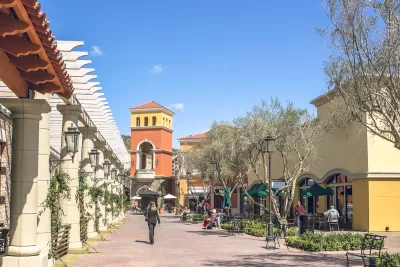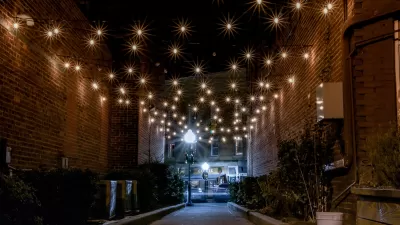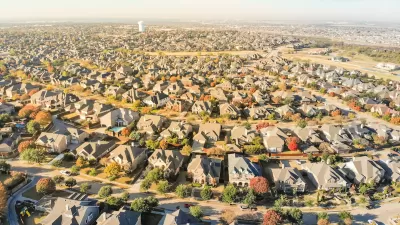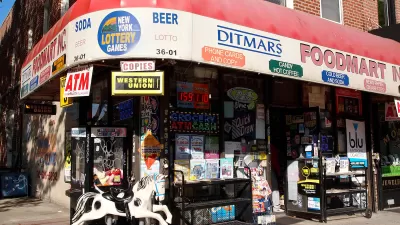Is the recent trend to build more walkable suburbs a sign of sustainable change?

Suburban developments are increasingly trying to mimic the walkability and vibrancy of urban neighborhoods, writes Alan Ehrenhalt in Governing. Is this a purely aesthetic shift, or is it a real movement toward more sustainable suburbs?
In Tempe, Arizona, 10 miles from Phoenix, a new community called Culdesac opted to remove private cars, offering access to transit, shared micromobility, and rental cars instead. According to Robert Steuteville, removing the need for car infrastructure inside the development “allows for a porous, fine-grain urban pattern with a network of narrow, shaded pedestrian-only paseos, intimate courtyards and a central plaza.” However, limited transit options mean that residents will often have to drive when leaving the community.
Ehrenhalt admits that the trend could be a blip. Lower housing costs — which could be brought on by the adaptive reuse of office buildings into residential units — could promote a stronger resurgence for urban city centers. But the strong demand for walkability among younger people is encouraging. “And if there is one thing we learned from the experience of the baby boomers, it is that when enough members of an emerging generation want something, they stand a very good chance of getting it.”
FULL STORY: A Possible Future for Downtowns Out in the Suburbs

Study: Maui’s Plan to Convert Vacation Rentals to Long-Term Housing Could Cause Nearly $1 Billion Economic Loss
The plan would reduce visitor accommodation by 25,% resulting in 1,900 jobs lost.

North Texas Transit Leaders Tout Benefits of TOD for Growing Region
At a summit focused on transit-oriented development, policymakers discussed how North Texas’ expanded light rail system can serve as a tool for economic growth.

Why Should We Subsidize Public Transportation?
Many public transit agencies face financial stress due to rising costs, declining fare revenue, and declining subsidies. Transit advocates must provide a strong business case for increasing public transit funding.

Dear Tesla Driver: “It’s not You, It’s Him.”
Amidst a booming bumper sticker industry, one writer offers solace to those asking, “Does this car make me look fascist?”

A Visual Celebration of Manhattan’s Chinatown Elder Community, Through Food
Lanterns, cafeteria trays, and community connection take center stage in this stunning photo essay.

How to Make US Trains Faster
Changes to boarding platforms and a switch to electric trains could improve U.S. passenger rail service without the added cost of high-speed rail.
Urban Design for Planners 1: Software Tools
This six-course series explores essential urban design concepts using open source software and equips planners with the tools they need to participate fully in the urban design process.
Planning for Universal Design
Learn the tools for implementing Universal Design in planning regulations.
City of Santa Clarita
Ascent Environmental
Institute for Housing and Urban Development Studies (IHS)
City of Grandview
Harvard GSD Executive Education
Toledo-Lucas County Plan Commissions
Salt Lake City
NYU Wagner Graduate School of Public Service





























